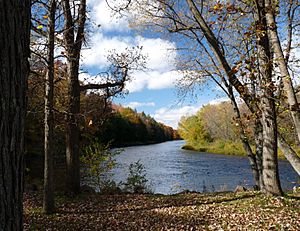Jump River facts for kids
The Jump River is a small, rocky river in northern Wisconsin. Long ago, in the late 1800s, people used it to float logs down to the Chippewa River. Today, it's a fun place for outdoor activities. It winds through forests and farms, and is mostly used by people who love to fish and paddle boats.
Contents
Where the Jump River Flows
The Jump River starts when two smaller rivers, the North Fork Jump River and the South Fork Jump River, join together in southwestern Price County, Wisconsin. From there, it flows for about 25 miles (40 kilometers). It passes through Rusk, Taylor, and Chippewa counties.
Finally, the Jump River flows into the Holcombe Flowage, which is a part of the Chippewa River. Eventually, its water reaches the mighty Mississippi River.
Small towns along the river include Sheldon, Jump River, and Prentice.
The River's Name and Early Days
The name "Jump River" has a few different stories behind it.
- Some people think it's because the water "jumps" over many rapids, especially in the first half of the river.
- Others believe it was named after a big forest fire in the 1800s that "jumped" over the river.
- Another idea is that log drivers, who floated logs down the river, noticed the water level would "jump" up and down quickly after it rained or when snow melted.
The Ojibwe people, who lived here long ago, called this river Manidoons-ziibi, which means "Little Spirit River." This name doesn't help explain the "Jump" part.
Native Americans lived along the Jump River many years ago. They grew small gardens of crops on the rich land near the river.
Logging History
Before logging began around 1858, the Jump River valley was covered in thick forests. Early explorers in the mid-1800s saw many types of trees. These included hemlock, yellow birch, sugar maple, white pine, black spruce, tamarack, and white cedar. Hemlock trees were very common in most areas.
Logging crews first cut down the tall white pine trees. They stored these logs all winter. Then, from April to July, they would float the logs down the river to sawmills in towns like Chippewa and Eau Claire.
The last time logs were floated down the Jump River was around 1903. After that, other types of trees that don't float as well were cut down and moved by trains and trucks.
Bridges Over the Jump River
The very first bridge over the Jump River was a railway bridge built by the Wisconsin Central Railway in Prentice in the 1870s.
Other important bridges were built later:
- The "Black Bridge" near the village of Jump River was built in 1899 and 1900.
- Another railway bridge was built in Jump River in 1904.
- The Range Line wagon bridge in Jump River was built in 1909. It was damaged by ice in 1913 but was fixed.
- The Albert bridge, now on County H, was built in 1912.
- The La Follette Bridge, just east of Jump River, opened in 1933.
The worst flood ever recorded happened around Labor Day in 1941. Days of heavy rain made the river rise about twelve feet! This flood destroyed the Black Bridge and washed out the roads leading to the La Follette and Range Line bridges.
Fun on the Jump River
The Jump River is a great place for canoeing when the water is high enough. You'll find small rapids and rocks to steer around. The riverbanks are mostly wild, but roads and farms are often just behind the trees.
If the water level is medium to high, paddling from the village of Jump River to County H or Sheldon is a lot of fun. When the water is even higher, you can canoe from below Big Falls down to the village, or even above the Falls. You can check the current water levels at Sheldon here: [1].
Fishermen love to cast their lines in the many fishing spots along the river. You can find fish like northern pike, smallmouth bass, musky, walleye, catfish, redhorse, and suckers. The areas below the North and South Forks are special because they are one of only twelve places in Wisconsin where you can legally catch Lake Sturgeon.
Big Falls County Park, also known as "Jump River Falls," has a small gorge where the river rushes over big rocks. The park has a picnic area and walking trails along the river. There are also picnic spots at parks in the village of Jump River and Haley Park in Sheldon. Haley Park has a sandy swimming beach, just like "the swimming hole" about a mile above the village of Jump River.
In winter, when the river freezes over, people enjoy riding snowmobiles up and down the ice.



